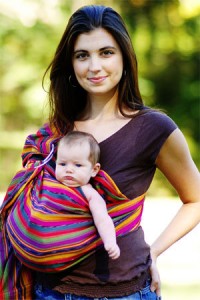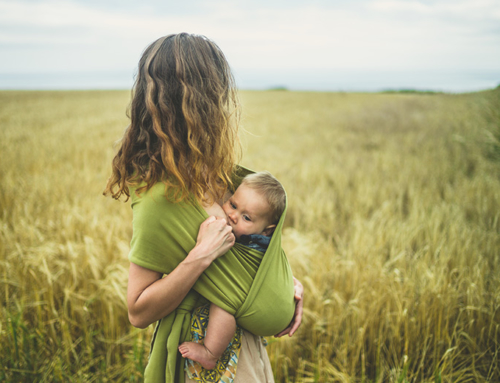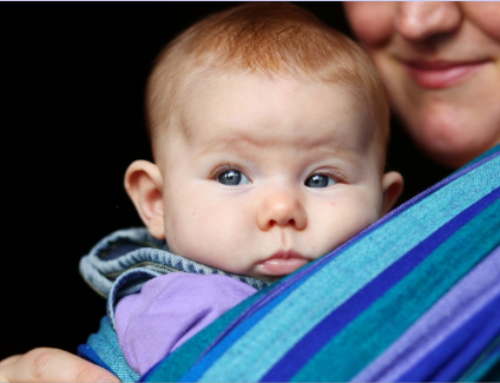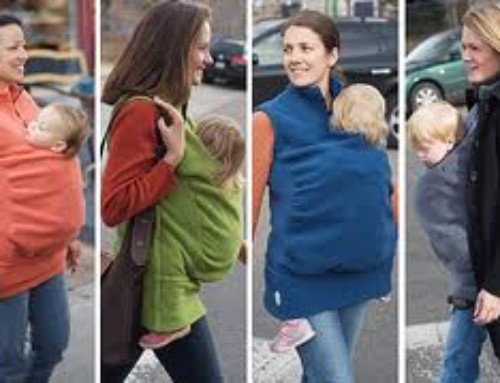By Tracy G. Cassels
 One of the simplest yet most effective aspects of Evolutionary Parenting is baby wearing. I’m also pleased to say it’s one of the ones making a rather large comeback after years of a stroller monopoly. These days you walk down the street and see many parents – moms and dads – carrying their babies in bjorn’s, ergo’s, wraps, etc., something that was rarely seen even just ten years ago. So why is baby wearing making a comeback? And why is it a good thing?
One of the simplest yet most effective aspects of Evolutionary Parenting is baby wearing. I’m also pleased to say it’s one of the ones making a rather large comeback after years of a stroller monopoly. These days you walk down the street and see many parents – moms and dads – carrying their babies in bjorn’s, ergo’s, wraps, etc., something that was rarely seen even just ten years ago. So why is baby wearing making a comeback? And why is it a good thing?
Oddly, I don’t actually believe the answers to these questions are related – the primary reasons baby wearing is good are most likely not the reasons people are doing it. In fact, most of the people I know who baby wear are completely unaware of the benefits to their child’s well-being or their relationship with their child; the reason they do it is simple – it’s easier. For anyone who’s lugged the stroller around, you probably know what a pain in the ass it can be. Just try getting into a store – you try to open the door while holding the stroller as the door then falls closed again or hits the stroller, waking up your little guy or simply hitting his arm which is hanging over the side. You eventually end up going into the store backwards because it’s the only way to both hold the door open and maneuver this large contraption though it’ll still hit the stroller or your child on the way in. And what if people try to help you out? They end up squashed against a wall with the wheels of the stroller going over their feet one at a time ensuring it’ll be a while before they extend that courtesy to anyone else. And heaven forbid you have to ride the bus – the dirty looks you get for having to take up valuable seat space for the stroller are enough to keep any sane individual off the bus as much as possible. Of course, you can always drive and pack your stroller in the car, but then where do you put all the things you go shopping for? Your massive stroller takes up all the space in the trunk. All in all, it’s enough to give anyone a headache.
In contrast, the simplicity of baby wearing means you avoid all of these hassles. You can open doors, cook, clean, walk, shop, talk, nurse, hold a coffee, eat a muffin and so much more all while holding your child close and getting to where you need to go. You can sit on one seat on the bus, thus avoiding the wrath of the masses. A carrier takes up a fraction of the space of a stroller, thus enabling you to bring it places with little to no inconvenience (note that the cloth wraps are particularly great for this – fold ‘em up and they’ll fit in a diaper bag). This is particularly helpful for traveling where you can now end up paying obscene amounts of money to check oversized items (like strollers). All in all, life becomes much easier when your child is attached to you instead of some gizmo with wheels.
While the structure of our society has changed to become more complex and industrialized, there is nothing in our behaviour that has changed that would suggest this type of closeness is no longer needed or beneficial to babies. In fact, research out of Sweden has shown that newborns will reactively cry when separated from their mother[6], suggesting that it is their innate preference to be as close to their mother as possible, regardless of where or when they were born. And the benefits of baby wearing are not limited to those in hunter-gatherer societies. While the safety of babies is less of a concern in Western societies, the ease factor is obviously quite relevant and the benefits with respect to comfort and attachment have also been observed in Western societies. In one study, researchers found that mothers who used a baby carrier were more responsive to their infants at 3 ½ months and showed a more securely attached pattern at 13 months[7]. This study also suggests that perhaps the reduction in fussiness seen elsewhere may be partially due to the physical contact with mom, but also the physical contact seems to increase mom’s responsiveness to baby. This responsiveness, in turn, may also help to reduce fussing as the babies are aware their needs are being met and thus don’t need to fuss to get attention. Regardless of the reason, the science remains the same – babies who are worn by their caregiver are calmer, happier, less fussy, and more securely attached than those who spend less time in their mother’s arms. Given this, it is difficult to understand why anyone wouldn’t baby wear, at least for the beginning months when baby is light enough (although you adapt quite readily to their growing weight). I realize that stroller companies probably hate this fact, and it’s partly why we are presented with ever more flashy strollers – ones that turn, multiple cup holders, rain covers, sponge wheels, etc. It’s as if by making them as exciting as possible, we’ll think that we must need them; after all, we are a society obsessed with its gadgets. And while it’s been working, I do believe that the tide is turning and people are starting to realize that the $700 they could spend on a fancy stroller would be better off as $100 towards a great wrap to carry their baby and $600 in a RESP for their child’s education. When you child truly is too big to be carried, there are plenty of cheaper but useful strollers that will suit you just fine. Or, by that time, your child could just walk – after all, it is what we’ve evolved to do. [1] Konner, M. Hunter-gatherer infancy and childhood. In Hewlett BS & Lamb ME (Eds.) Hunter-Gatherer Childhoods: Evolutionary, Developmental, and Cultural Perspectives (2005). Transaction Publishers: New Brunswick, NJ. [2] Ibid. [3] Uvnas-Moberg K. The Oxytocin Factor: Tapping the Hormone of Calm, Love, and Healing (2003). Da Capo Press: Cambridge, MA. [4] https://www.brainhq.com/blog/your-brain-in-love-part-4-oxytocin-the-lovehate-hormone/ [5] Hewlett BS, Lamb ME, Shannon D, Leyendecker B, & Scholmerich A. Culture and early infancy among central African foragers and farmers. Developmental Psychology 1998; 34: 653-661. [6] Christensson K, Cabrera T, Christensson E, Uvnas-Moberg K, & Winberg J. Separation distress call in the human neonate in the absence of maternal body contact. Acta Paediatrica (1995); 84: 468-473. [7] Anisfeld E, Casper V, Nozyce M, & Cunningham N. Does infant carrying promote attachment? An experimental study of the effects of increased physical contact on the development of attachment (1990). Child Development; 61:1617-27. But ease was only part of the evolutionary story. The other parts consist of safety and what’s best for babe. Previously, one of the only ways to ensure your infant’s safety was to make sure they were with you at all times. In former (and current) hunter-gatherer societies, infants spend considerably more time attached to their mother (or another person, but primarily the mother) via a baby wrap
But ease was only part of the evolutionary story. The other parts consist of safety and what’s best for babe. Previously, one of the only ways to ensure your infant’s safety was to make sure they were with you at all times. In former (and current) hunter-gatherer societies, infants spend considerably more time attached to their mother (or another person, but primarily the mother) via a baby wrap





I love it! My personal pet peeve is when I am out with my baby in my sling and get the admiring glances from people of my parents-and-up age followed by ‘oh, those are so lovely, I wish they had them when my kids where little!’ I can usually contain myself to a baffled look and some polite mutter or another. How exactly did people get to child bearing age and never see a pic or discription of any one of a hundred(s) different forms of babywearing common throughout history and culture? Just because something wasn’t sold in a store doesn’t mean it didn’t exist! (And it’s not like it’s hard to make or anything, a long piece of cloth is sufficient)
Oh, and skin-to-skin isn’t really reliant upon the weather (although admittedly more common in tropical and subtropical weather), traditionally Innuit babies were naked in the pouch/hoods of their babywearing moms!
In a completely unrelated note, do you have a subscription sign up for comment streams and I’m just missing it?
Hey Jespren,
First, before I forget, I’ve asked my hubby to look into the subscription sign up for comments as he’s the one dealing with site maintenance 🙂
I get many comments on my wrap (which is a beautiful mixed blue/green/purple) and many are totally unaware where to get many of the types of wraps. It is remarkable how much the baby economic industry has completely taken over what becomes the norm for so many nowadays. On a side note, though, one of the best comments I got was in a store once where the security guard came up to me (which first had me a little worried that I’d done something wrong) and said that he loved the wrap and it reminded him of home (Africa, though he didn’t say where). He told me his mother used these kinds of wraps for him and all his siblings and he had very fond memories of the experience and seeing his siblings in it too. I don’t think I’ve ever heard anyone talk longingly of their days in a stroller so it just helped reinforce what a wonderful bonding experience babywearing is for children too!
Oh! That would be a great complement! And hey, my wrap is a blues/purples mix too (no green though). I use a maya ring sling because it was donated to me. Previous to getting that donated I was planning on just the traditional wrap a long cloth around the both of you type of babywearing, but I find the ring sling more convienent and, it has a pocket!
My almost 3 year old has mostly outgrown the babywearing phase but if he’s feeling stressed or sick or overwrought he still asks (and sometimes gets) for ‘mama back’ or ‘moma ‘ing’ (sling). I’d indulge him more often, since I think he’s still at a mental age to benfit from it, if I didn’t have bad joints. Unfortunately hauling around a 36lb toddler who is more than half as tall as I has a tendency of pulling rins out of socket! So getting carried around by mommy is more of a treat than a commonality for him. Most the time he wants to walk anyway.
I don’t think I’ve ever heard of someone fondly remembering their stroller either! Although I am reminded of stories of Native American children carrying around their papoos as a comfort item after they outgrew them!
[…] evolutionary parenting To learn about benefits to baby wearing check out this awesome article from Evolutionary Parenting. Tweet This entry was written by Lindsay, posted on September 13, 2011 at 12:28 pm, filed under […]
[…] There are so many benefits of baby-carrying! It promotes positive attachment patterns, its comforting for the child to be close to the Mom, hear her heart beat, etc., it promotes baby’s ability to regulate their own body temperature efficiently, it allows Mom the freedom to move about with ease and to use her hands (cooking, typing at the computer, folding clothes). It’s also totally natural! Although most people today see it as “new-age” or “hippy-ish,” this was how ALL of our ancestors used to handle having infants (check out this article). […]
I’ve been baby wearing for 10 years and the market has really exploded in that decade. Don’t be too hard on the older generation ~ I had my first baby 21 years ago and there was no internet and unless you lived in a really hippy town, you bought stuff from sears and Toys r Us and if they didn’t stock it, we didn’t buy it.
And I do know one person who fondly remembers her stoller ~ my 9 year old daughter. I wore her, too, but she just really liked her stoller. I write this with my 4 month old calmy napping in my moby wrap 😉
I encourage all my clients to invest in a baby carrier. I bring my own when I do postpartum care and show the parents how well it calms and soothes their baby, usually sending them off to sleep!
There needs to be education though regarding the style that is used as some parents put their newborn in a carrier that splays out their legs, displacing the hips and that’s not good.
Either a wrap or sling style works best for the wee newborns until they can open their legs wider. As well, forward facing puts too much strain on their developing spines and so they need to be carried always facing you.
Wearing your baby is such a wonderful way to be with them. Especially in those early months – the fourth trimester.
I have the Ergo and love it, over my expensive strollers! I use my carrier way more that the stroller. Some times It is a must to use the stroller but I will still bring my ergo along in case by lil man needs to be close to me. I also have a 4 year old so keeping my hands free to be able to help with her needs is key. With my first iIdidn’t use a carrier bc it hurt my back so bad and she did seem to be fussier then my second. The Ergo doesn’t hurt my back its very comfortable.
I know this is an old post, but wanted to add my two-cents worth! I love my baby wraps, and used almost exclusively for 6.5 months. Then my back kept feeling very stiff. I still love them for certain things but if I have to walk long distances ( I prefer to not take the car) or if I want to get a brisk walk in and can’t leave the baby at home to be cared for by the two dogs while dad is at work, then I use the stroller. But I agree with your other blog “consequences of babywearing” (or such) that I definitely connect with my child more when babywearing. It has inspired me to order a mei tai (my wraps are too stretchy for bub now) so I can keep the little man close more often 🙂
I didn’t discover baby wearing until my oldest was about a year old. It was a life saver. He still likes to be worn. But then I had my second child. And while he was held a lot as a baby, and nursed on demand (about every 20 min at a newbor), he didn’t like to be worn. He doesn’t like to be confined or restricted. When he got a little older and mobile, he was up and down so much exploring it was less hassle just to hold him rather than wear him. Some AP parents think I’m not AP enough because I don’t baby wear him, but the fact is he simply doesn’t like it!
[…] galactagogue and the convenience of carrying your baby around with you, baby wearing have far more benefits than I […]
When I was pregnant, I read all about the benefits of baby wearing and decided I would definitely do that. So I got 4 different types of carriers, and no stroller. My son is now 3 months old and while he likes being in the carrier for a little while, he starts to cry and even scream whenever I put him in the second time in a day. The weather is very hot right now, and that may be why, but I am getting frustrated with baby wearing because I feel like I can’t go anywhere too far or for too long, because then he doesn’t want to go back into the carrier, and how am I supposed to carry him home? Also, he breastfeeds very frequently, and while I have breastfer him in the carrier, I find it difficult, and almost impossible without someone to help me adjust the carrier. I would appreciate any help from the babywearing experts. Thanks!
Have you checked out wrapyourbaby.com for ideas on how to adjust and wear while breastfeeding?
As for the carriers – what kinds do you have?
Hi Tracy,
thanks for your response I have an Ergo, a Mei Tai, an infantino ecosash, a stretchy wrap, and a ring sling. I have checked out that site, yes, thanks. I have also joined a baby wearing lending library in order to try out other carriers. I have also recently discovered that there are haby wearing meet ups here in Vancouver, and I will be going to one tomorrow! So hopefully with some in person help, things will get easier. Thanks!
Aside from the security, well-being, and safety of carrying infants, there are physical reasons for this as well. Strollers act as a full baby cast for the infants, meaning they are not building much strength, especially their core muscles (different forms of carrying often do work at least some musculature of the baby, whether that be the neck, or the core when carried in arms). Not to mention, the care givers lose out on the added weight strain to the their skeletal system, which builds stronger bones). This is not to say that strollers have no use ever, but using these as the primary way of carrying a child ultimately hinders musculoskeletal development/maintenance of the infant and care giver. Keep in mind, estimates of hunter-gatherer moms suggest they carried their infants for 3000 miles over the course of infanthood. That’s wild (literally and figuratively). Thank you for posting this wonderful article.
[…] The Benefits of Babywearing […]
I write this with my 15-week-old in our WildBird ring sling after falling asleep while I made myself lunch 🙂
Her daddy said something early on that really drive home my decision to babywear: we had her in her pram on Halloween because her costume was so poofy I couldn’t safely wear her and the sling obscured the cuteness of the costume. (It’s one of the 4 times in 15 weeks she been in her stroller.) Less than 2 minutes in he stopped and said “I wanna pick her up. She doesn’t feel like part of the family down there.” And he proceeded to do so. I said “now you see why I wear her” and smiled. In that moment I felt he truly got why it feels so right and so good for me. He recently carried her for theor first big stretch on a 90 minuted historical walking tour of Old Montreal. I was so proud. But we need to get him a carried because the ring sling isn’t great on the male body lol. I joke he doesn’t have the built in pillows 😉
[…] during autumn than hoping my 5 pounder would stay warm in the stroller. Babywearing can help increase oxytocin (the bonding hormone) and therefore milk production for […]
[…] https://gku.flm.mybluehost.me/evolutionaryparenting.com/the-benefits-of-baby-wearing/ […]
[…] even beyond that, there are biochemical responses in both your body and your baby’s when you wear him! Each of you release oxytocin, the […]